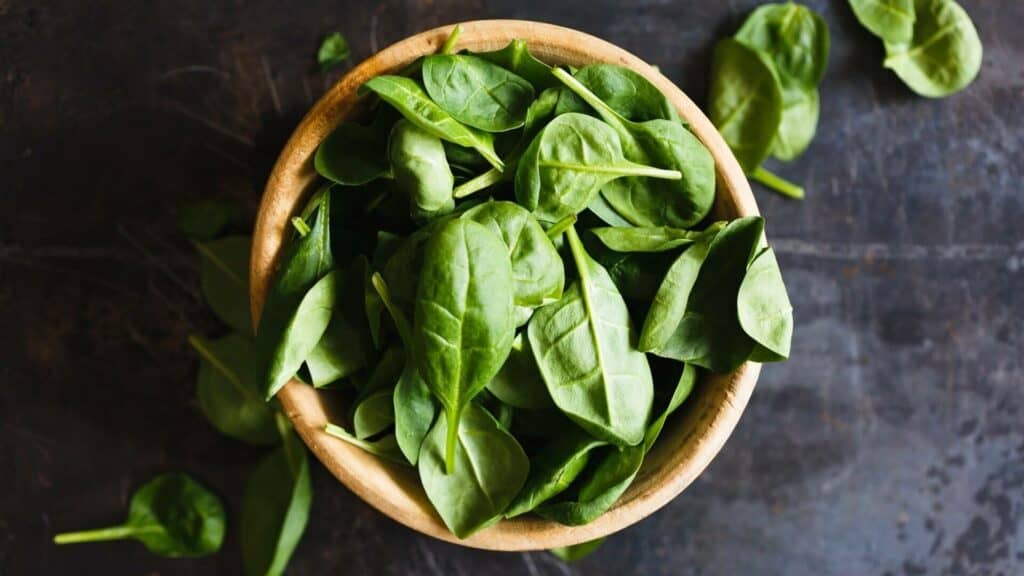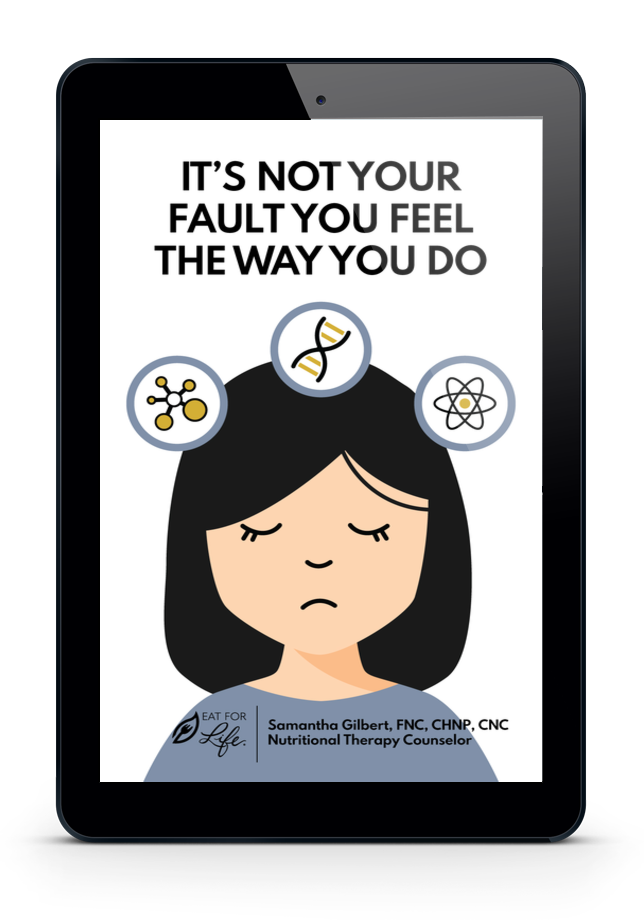Vegan diets and spinach-packed green juice have become symbols of health, vitality, and saving the planet, but is there a dark side to consuming high amounts of plant-based foods?
Plants have inherent chemical defense systems that protect them from invaders. One such chemical is oxalate or oxalic acid, and you’ll see, it can wreak havoc on your mind and body.
To learn more about oxalate toxicity, check out my podcast episode 46 below with Sally K. Norton, author of Toxic Superfoods, How Oxalate Overload is Making You Sick and How to Get Better. You can also find the Eat For Life podcast on Apple Podcasts, Spotify, Google Podcasts, or wherever you listen to podcasts!
What Is Oxalate?
Oxalate is a naturally occurring compound that’s found in a wide variety of plants. It’s a very small molecule that starts off as oxalic acid, which is a two-carbon molecule that has four oxygen atoms. This gives it a lot of oxidative powers. It’s also a chelator that grabs minerals. It loves to connect with minerals to form compounds, including calcium oxalate.
What’s so interesting about this little molecule is that it can switch forms and it likes to partner with other minerals. Essentially, oxalate is a general term for oxalic acid and oxalate crystals.
What Is Oxalate Toxicity?
Oxalic acid toxicity was uncovered in England in 1840 after doctors began to notice that in the spring when wealthy people ate a lot of rhubarb tarts (which are very high in oxalate), odd symptoms began to occur such as digestive and neurological problems. Adding this mega source of oxalate on top of a daily diet consisting of black tea and white potatoes (both high in oxalate) was the beginning of understanding how this plant compound impacts human physiology.
Plants use oxalic acid to build calcium oxalate crystals that they use for myriad purposes. One purpose is to defend themselves from being eaten. By building these crystals, they make a lot of oxalic acid, which allows them to shape their metabolism. This is a brilliant process for them, but people that eat high oxalate foods can be overloading themselves with a compound that is quite toxic to humans.
As I shared previously, oxalic acid grabs minerals from your food and lowers the amount you absorb. The acid is the part that gets into your bloodstream and eventually hooks up with the minerals in your blood or tissues and lowers the amount of minerals there. So essentially, you have fewer minerals available for optimum health and to build strong bones. This causes your bones to act as a buffer due to their loss of calcium. They also have to buffer the acidity because oxalate creates chronic acidity.
It actually doesn’t take long to start developing early osteopenia and osteoporosis on a plant-used diet high in oxalate.
What Are Oxalate Toxicity Symptoms?
A commonly known side effect of oxalate toxicity is kidney stones, but oxalates impact the body across multiple organ systems and are also neurotoxic leading to joint pain, gastrointestinal issues, genital and rectal pain, and gut problems, to name a few.
In fact, a common neurotoxicity symptom is hiccups, which is a muscle spasm that occurs when nerves aren’t working properly. If you notice hiccups after a meal consisting of high oxalate foods, this means your diaphragm and vagal nerve are not happy because they’re overloaded with oxalates. Symptoms and conditions connected to oxalate overload include:
| Anxiety Arthritis Belching Chemical sensitivities Clumsiness and dropping things Connective tissue disorders Constant infections (urinary tract (UTI), vaginal (yeast), and sinus infections) | Depression Digestive issues Fibromyalgia Genital pain (burning with urination) Hiccups Joint pain Kidney stones Leaky gut | Osteopenia Osteoporosis Rectal pain Rheumatoid arthritis Skin issues such as rashes and dermatitis Sleep problems Vulvodynia (chronic pain around the opening of the vagina) |
What Foods Have A lot of Oxalates?
Many plants contain high amounts of oxalate. The worse offenders include:
| Almonds Beets Beet greens Black pepper Black tea Cacao Cashews Chia Cinnamon | Clove Figs Guava Hemp Kiwi Lentils Peanuts Potato Quinoa | Raspberries Rhubarb Sorrell Spinach Starfruit Sweet potato Swiss chard Teff Turmeric |
Oxalate and Leaky Gut
In my clinic, I notice that heavy antibiotic use beginning in early childhood and beyond can significantly predispose a person to oxalate toxicity. Individuals with a history of recent or heavy antibiotic use may be at much greater harm from dietary oxalate because most antibiotics destroy the flora that degrades oxalate.
Additionally, individuals that are born with high amounts of oxidative stress (and therefore an impaired gut microbiome) such as those with autism, ADHD, OCD, and eating disorders are also at greater risk of being harmed by dietary oxalate.
Oxalobacter formigenes, an anaerobe bacterium, cannot survive without eating up oxalate. Several studies have shown that those who develop oxalate-related disease generally lack oxalobacter in their stool.
An inflamed or leaky gut absorbs five to 10 times more oxalate because oxalic acid is a single ionic molecule that’s riding in water, just like a dissolved piece of sodium. Oxalic acid rides in water between cells in junctions that connect cells and hold them together. They act like velcro, where there are spaces in between the velcro that the water is flowing through. But when you have leaky gut, there are big gaps in the velcro, which allows oxalate to flood in.
Oxalate crystals are like sandpaper to the GI tract, therefore creating more inflammation that increases leaky gut. Oxalate takes the basic structure of a cell and puts it in oxidative stress, which interrupts mitochondrial health and puts a lot of inflammatory stress on cells.
This is a nightmare for your gut microbiome because oxalate kills bacteria and creates dysbiosis and yeast overgrowth. Oxalate also impairs the ecology of the body, making it more acidic, which encourages yeast and other pathogens to proliferate. With yeast overgrowth, we tend to see decreased excretion and higher levels of oxalates in the body.
If you’re prone to infections such as urinary tract infections, vaginal yeast infections, and sinus infections, a low oxalate diet along with gut restoration therapy might be something to look into.
Is There An Oxalate Toxicity Test?
Testing urine to measure oxalate and other metabolite levels is available but it’s not very reliable. Kidney function, as well as ultrasound or computerized tomography (CT) scan to check for kidney stones or calcium oxalate deposits, can also point to oxalate overload in the body.
Is There An Oxalate Toxicity Treatment?
How do you flush oxalates out of your body? By going slow.
Healing from oxalate toxicity involves a multifactorial approach that includes dietary and nutrient therapy, as well as gut restoration. You can start the healing process today by simply reducing high oxalate foods from your diet.
Keep in mind that the initial worsening of symptoms is part of the healing process (known as oxalate dumping) when the body lets go of accumulated oxalate, so I encourage slowly reducing your intake.
Before you begin, take an inventory. For example, do you eat chocolate or spinach every day? Remove one of these first, then move on to the next high oxalate food, then the next.
Additionally, yeast can have a compound that looks like vitamin C (an ascorbate-type compound), so it’s possible that vitamin C could degrade into oxalate but there’s currently no research to prove this is true. Vitamin C is an important antioxidant and is an important nutrient in balancing copper (as part of an overall nutrient therapy plan), so dosing will depend on an individual’s chemistry and symptoms.
Lastly, consider taking a calcium citrate supplement with high oxalate foods to bind oxalate.
Can Oxalates Cause Autism?
A low oxalate diet can be a helpful healing tool in autism recovery, but oxalates do not cause autism and a low oxalate diet alone will not cure autism.
Autistic individuals suffer from a severe amount of oxidative stress. Further problems with methylation, copper toxicity, and enzymes not functioning properly are all triggered by environmental insults that can have devastating effects. The in utero environment is of critical importance because our methylation status is assigned during this delicate time, which is why I encourage all parents to get tested and treated with nutrient and dietary therapy prior to conception. You can significantly reduce the chances of your child developing autism, ADHD, or mental health challenges with this approach.
Click here to listen to my podcast episode about the underlying causes of autism.
Nutrition Counseling To Help You Thrive
If you’d like to understand how oxalate may be impacting you, let’s look at identifying and addressing the root biochemical causes and imbalances of your symptoms, which includes testing and analysis.
I offer a free 1:1 consultation to help you disconnect from the hype and the marketing jargon, and address the true source(s) of your discomfort.
The highest oxalate foods have been championed as superfoods, but are they really super?
I encourage you to consider how oxalate is playing into our current crises in chronic disease. How is it playing into what we think of as normal aging such as frailty, stiffness, low muscle mass, poor metabolism, and low energy?







5 Responses
Please note… It’s only synthetic vitamin C that can deplete copper. Natural vitamin C from food or from some supplements that utilize food sources contains copper as part of it’s molecule.
Also anything that is made with citrate, unless it’s from natural citric acid, should be avoided. Citric acid is usually made in a laboratory using GMO corn and black mold and has been shown to be inflammatory and can negatively affect ceruloplasmin levels in the body.
Please note regardless of the form, vitamin C must be taken with other nutrients as part of an overall nutrient therapy plan to safely balance copper. Ascorbic acid if taken alone will not reduce copper.
Steve. As a beginner at all this I would appreciate your knowledge about ceruloplasmin. Also how do I identify natural citric acid. Many thanks. Evelyn
I cannot eat grains, legumes, nightshades, and dairy including eggs. The only dairy I can have is yogurt and Bulgarian feta. Now my Naturopath and my muscle testing confirms I need remove the high oxalate foods that are left. I need meal planning and recipe help. Do you have recipes?
Are oxalates destroyed in cooking?
Where can I find a list of safe foods that are low oxalates?